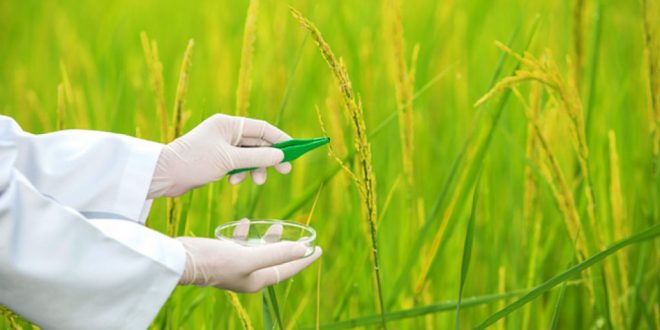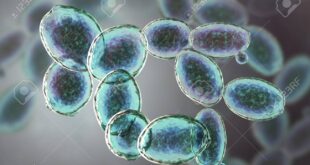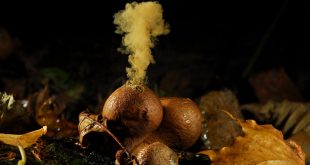Rice, Oryza sativa is one of the main staple crops in the whole world especially in Asia. It provides carbohydrate and calories daily to about half of the world population. Besides, in some countries, this annual plant acts also as an economic crop and serves as a source of foreign income. Round the year billions of tons of rice are consumed and billion others are exported worldwide.
Here are some quick fun facts about rice.
- Rice is the grain from species Oryza sativa (Asian rice) or Oryza glaberrima (African rice).
- There are over 40,000 varieties of rice. The three favorites are Basmati, Thai Jasmine and Italian Arborio.
- Two Japanese car brands were named after rice: Toyota, meaning “Bountiful Rice Field,” and Honda, meaning “Main Rice Field”.
- It takes 5000 liters of water to produce 1 kilo of rice.
Here are some of the common and important diseases of rice that farmers deal with nationwide. But before delving into them, we need to know about some disease prone parts of the plant so that it becomes easy for us to know where to look and what to find in paddy to identify diseases.
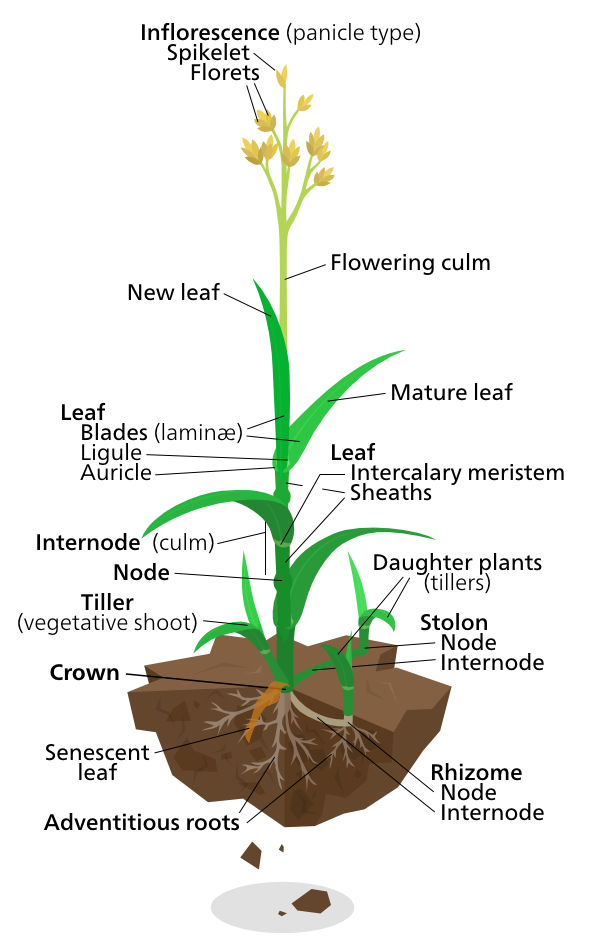
Some fundamental terms about the parts of paddy
- Leaf sheath: A structure at the base of a leaf’s petiole that partly surrounds or protects the stem or another organ that it subtends.
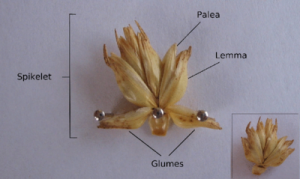
A spikelet of paddy - Panicle: A loose branching cluster of flowers.
- Glumes: Each of two membranous bracts surrounding the spikelet of a paddy.
- Spikelet: The basic unit of a paddy flower, consisting of two glumes or outer bracts at the base and one or more florets above.
Diseases described here are:
- Blast disease of rice
- Brown spot of rice
- Stem rot of rice
- Sheath blight of rice
- Sheath rot of rice
- Foot rot or Bakane disease of rice
Blast disease of rice
This particular disease is considered as the most significant disease of paddy as it has extensive distribution and destructiveness all over the rice growing countries. Affected by this disease, the plant may get destroyed at any stage between the seedling and the tillering periods.
Several rice blast epidemics have occurred in different parts of the world, resulting in yield losses in these areas ranging from 50 to 90% of the expected crop.
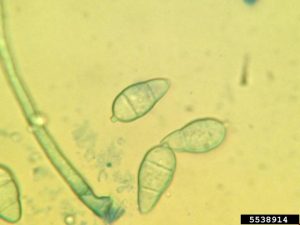
Pathogen
- Pyricularia oryzae
- Synonym: Magnaporthe oryzae (Teleomorph stage) (Has not found in nature but produced in laboratory)
- Class: Deuteromycetes
Characteristics of pathogen
- Conidiophore simple, hyaline or straw colored.
- Conidia pear-shaped, mostly two-septate.
- Conidia are terminal in position.
Infected portions
- All parts of the paddy plant except the root. The fungus can infect the plant at any growth stage.
- Main infection occurs in leaves. In severe cases, also in grain.
Symptoms
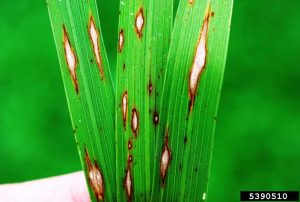
- Initial lesions (tissue that suffered damage) with dark green borders.
- Older lesions are spindle or diamond shaped. They are with whitish gray central part and brownish or necrotic border.
- The spots enlarge as the disease progresses. And they may coalesce, and kill entire leaves.
- Neck of the panicle becomes black. The panicle breaks at the neck due to weakening of the neck tissue.
Control measures
- Proper weeding of collateral host.
- Using some epidermal fungicide such as Bentate.
- Use of disease resistant varieties such as BR3, BR8 etc.
Disease enhancing abiotic factors
High amounts of rainfall and high levels of nitrogen fertilizer.
Photo gallery


to white heads. (D) Severe blasting of rice panicles in the field.
Brown spot of rice
It is one of the most common and most destructive diseases of rice. And it was behind the infamous Bengal famine of 1943 when approximately 2 million people died from starvation. One interesting fact about this disease is that it was considered to be used against Japan by USA during the World War II.
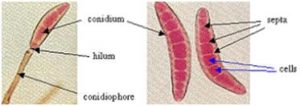 Pathogen
Pathogen
- Drechslera oryzae
- Synonym: Cochliobolus miyabeanus, Bipolaris oryzae (anamorph).
Characteristics of pathogen
- Branched conidiophore with septation.
- Conidia are black colored with pseudoseptation.
Infected portions:
- Main infection in leaf and leaf sheaths.
- Also seen in grain, stem except roots.
Symptoms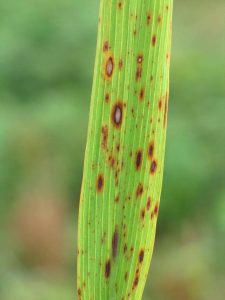
- Small, circular brown spots on leaf and leaf sheaths.
- The spots are round to oval. They are usually isolated and occur in the upper surface of leaf lamina.
- Fully developed lesions have a light brown to grey centers surrounded by a reddish brown margin.
- Entire glumes may be covered by several small spots or one large spot.
- The base of the panicle becomes shrunk and discolored.
Control measures
- Using disease free seeds.
- Hot water treatment.
- Using fungicide.
Good to know
- The fungus causes damage primarily by attacking the leaves during the seedling stage.
Photo gallery

miyabeanus. (Photograph courtesy of Plant Pathology Department,
University of Florida.)
Stem rot of rice
Pathogen
- Sclerotium oryzae
Characteristics of Pathogen
- Growth of mycleia is very rapid.
- They produce small, black, pinheaded sclerotia.
Infected portions
- Mainly in the stem. Also in the inner side of the leaf sheath.
Symptoms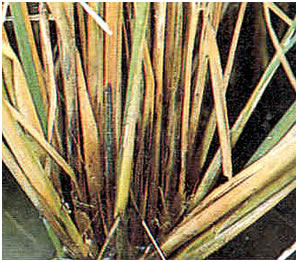
a. At the early stage of disease development, irregular black lesions are found on the outer leaf sheaths near the water level.
b. Visible, numerous tiny dark brown or black sclerotia are found in the stem.
c. Stem fiber becomes bust because of infection.
Control measures
- Using disease free seed.
- Using homiseed treatment by blankets, agrasen.
- Hot water treatment (fungus dies at 50-52 degree celcius).
Sheath blight of rice
Pathogen
- Rhizoctonia solani
Characteristics of pathogen
- Mycelia present.
- At the advanced stages, brown sclerotia are formed. They are easily detached from the spots.
Infected portions
- Leaf sheath. But infection starts at the base of the plant.
Symptoms
Usually observed from tillering (shoot growing after the initial parent shoot is grown) to milk stage.
- Oval or ellipsoidal greenish gray lesions, usually 1-3 cm long, on the leaf sheath, initially just above the soil or water level in the case of conventionally flooded rice.
- Under favorable conditions, these initial lesions multiply and expand to the upper part of the sheaths, the leaves, and then spread to neighboring tillers.
- Lesions on the leaves, as they grow older, usually have irregular pattern, often with gray-white centers and brown margins.
- The infected area look like snake.
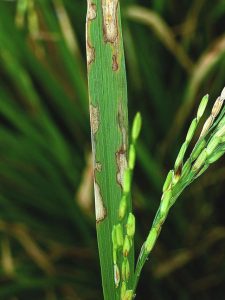
Outcome
- Leaves dry out rapidly and die then. As a result, the leaf area of the canopy gets significantly reduced.
Disease enhancing abiotic factors
- High temperature (28−32°C)
- High levels of nitrogen fertilizer, and
- Relative humidity of crop canopy from 85−100%.
Good to know
- Plants are more vulnerable to this disease during the rainy season.
Sheath rot of rice
Pathogen
- Sarocladium oryzae
Characteristics of pathogen
- Mycelia and conidia develop.
- One celled conidia, hyaline and no septum present.
Infected portions
- Mainly occur in flag leaf sheath.
Major symptoms
- Lesions develop.
- The spots are brown in color.
- Spots like structure are present in the infected area.
Control measures
- Use healthy seeds.
- Apply potash at tillering stage.
- Apply foliar spray: CaSO4 and ZnSO4.
- Use seed treatment fungicide like carbendazim, mancozeb.
- Foliar fungicide can also be used. Examples: Benonyl, Copper oxychloride.
Foot rot or Bakane disease of rice
Pathogen
- Fusarium moniliforme
Characteristics of pathogen
- Two types of conidia present: Macroconidia and microconidia.
- Macroconidia are semilunar and microcondia are globular.
- Conidia have septation.
- Conidia borne in chain at the tip of conidiophore or branch of conidiophore.
Infected parts
- Mainly in the young seedlings.
- May spread over the leaf sheath in later stage of development.
Symptoms
- In seedlings, the grains fail to germinate or seedlings fails to emerge above the soil.
- The affected seedlings become thin, pale and tall. The seedlings wilt and die.
- In severe infection, the pinacle doesn’t develop or a whitish sterile ear is developed.
- Adventitious roots develop.
Best safe and secure cloud storage with password protection
Get Envato Elements, Prime Video, Hotstar and Netflix For Free
 Plantlet The Blogging Platform of Department of Botany, University of Dhaka
Plantlet The Blogging Platform of Department of Botany, University of Dhaka
